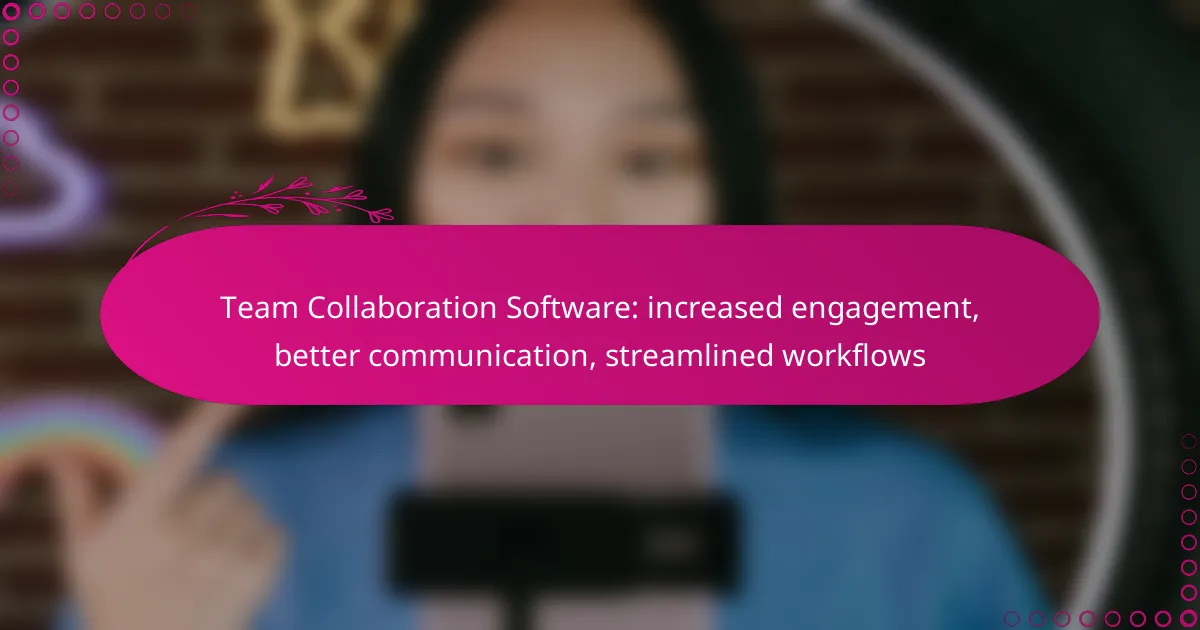Team collaboration software plays a crucial role in enhancing engagement and improving communication within organizations. By streamlining workflows and fostering an interactive environment, these tools enable team members to share ideas and feedback effortlessly, ultimately driving productivity and motivation. Popular platforms like Slack, Microsoft Teams, and Asana cater to diverse team needs, ensuring that collaboration is both effective and efficient.

What are the best team collaboration software solutions in the UK?
The best team collaboration software solutions in the UK enhance engagement, improve communication, and streamline workflows. Popular options include Slack, Microsoft Teams, Trello, Asana, and Monday.com, each offering unique features tailored for diverse team needs.
Slack
Slack is a widely-used messaging platform that facilitates real-time communication among team members. It allows users to create channels for specific topics, making it easy to organize discussions and share files.
Consider integrating Slack with other tools like Google Drive or Trello for a more cohesive workflow. However, be mindful of notification overload; setting channel-specific alerts can help manage this.
Microsoft Teams
Microsoft Teams combines chat, video conferencing, and file sharing in one platform, making it ideal for teams already using Microsoft 365. Its seamless integration with Office applications enhances productivity.
When using Teams, take advantage of its meeting features, such as scheduling and recording, to keep everyone on the same page. However, ensure all team members are trained on its functionalities to maximize effectiveness.
Trello
Trello is a visual project management tool that uses boards, lists, and cards to organize tasks. It’s particularly useful for teams that prefer a Kanban-style approach to track progress and responsibilities.
To get the most out of Trello, regularly update cards and use labels for prioritization. Be cautious of overcomplicating boards; keeping them simple can enhance clarity and focus.
Asana
Asana is designed for task management and project tracking, allowing teams to create projects, assign tasks, and set deadlines. Its user-friendly interface helps teams stay organized and accountable.
Utilize Asana’s timeline feature for visualizing project deadlines and dependencies. Regular check-ins on task progress can prevent bottlenecks and ensure timely completion of projects.
Monday.com
Monday.com is a flexible work operating system that allows teams to customize workflows and project management. It offers various templates and automation features to streamline repetitive tasks.
When implementing Monday.com, start with a clear structure for your boards to avoid confusion. Regularly review and adjust workflows based on team feedback to enhance efficiency and collaboration.

How does team collaboration software increase engagement?
Team collaboration software boosts engagement by facilitating seamless communication and collaboration among team members. These tools create an interactive environment where employees can share ideas, provide feedback, and stay connected, leading to higher motivation and productivity.
Real-time communication features
Real-time communication features, such as chat, video conferencing, and instant messaging, allow team members to connect instantly, regardless of their location. This immediacy reduces delays in decision-making and fosters a sense of community within the team.
For effective use, teams should establish guidelines for communication to prevent information overload. Utilizing features like status updates can help indicate availability and prioritize urgent messages, ensuring that important discussions remain focused.
Interactive project management tools
Interactive project management tools enable teams to visualize tasks, track progress, and assign responsibilities in a collaborative manner. Features like shared calendars, task boards, and progress tracking help keep everyone aligned and accountable.
To maximize the benefits, teams should regularly update their project boards and hold brief check-ins to discuss progress and obstacles. This practice not only enhances transparency but also encourages team members to actively participate in the workflow, ultimately driving engagement.

What are the benefits of better communication in teams?
Better communication in teams leads to increased engagement, improved collaboration, and more efficient workflows. By fostering open dialogue and clear information sharing, teams can achieve their goals more effectively.
Enhanced productivity
Enhanced productivity is a direct result of improved communication within teams. When team members share information clearly and promptly, tasks can be completed more efficiently, reducing the time spent on clarifications and corrections.
For instance, utilizing team collaboration software can streamline project updates and task assignments, allowing members to focus on their work rather than on back-and-forth emails. Teams that communicate effectively often see productivity boosts of 20-30%.
Reduced misunderstandings
Reduced misunderstandings are a key benefit of better communication in teams. Clear communication helps ensure that everyone is on the same page regarding project goals, deadlines, and responsibilities.
To minimize confusion, teams should establish guidelines for communication, such as regular check-ins and using shared platforms for updates. This can help prevent costly mistakes and delays, as well as foster a more cohesive working environment.

How do streamlined workflows improve team efficiency?
Streamlined workflows enhance team efficiency by reducing bottlenecks and clarifying processes. This leads to quicker task completion and improved collaboration among team members.
Automated task assignments
Automated task assignments help distribute work evenly and ensure accountability. By using software that automatically assigns tasks based on team members’ skills and availability, teams can minimize confusion and delays.
For example, project management tools can send notifications to team members when a task is assigned, allowing them to start work immediately. This reduces the time spent on manual assignments and follow-ups.
Centralized information access
Centralized information access allows team members to find and share resources quickly, which is crucial for maintaining workflow efficiency. When all project-related documents, communications, and updates are stored in a single location, teams can avoid wasting time searching for information.
Using cloud-based platforms, teams can ensure that everyone has access to the latest versions of files and can collaborate in real-time. This setup not only boosts productivity but also enhances transparency across the team.

What criteria should you consider when choosing collaboration software?
When selecting collaboration software, focus on integration capabilities, user interface, and overall user experience. These factors significantly influence team engagement, communication, and workflow efficiency.
Integration capabilities
Integration capabilities refer to how well the collaboration software connects with other tools your team uses, such as project management systems, file storage services, and communication platforms. Look for software that offers seamless integration with popular applications to ensure a smooth workflow.
Consider whether the software supports APIs or has pre-built connectors for essential tools. This can save time and reduce errors by automating data transfer between systems. A good rule of thumb is to prioritize software that integrates with at least 5 to 10 of your most-used applications.
User interface and experience
The user interface (UI) and overall user experience (UX) are critical for ensuring that team members can easily navigate the software. A clean, intuitive design can enhance engagement and reduce the learning curve. Look for software that offers customizable dashboards and easy access to features.
Conduct trials or demos to assess the UI and UX. Gather feedback from team members to ensure the software meets their needs and preferences. Aim for a platform that minimizes clicks to complete tasks, ideally requiring no more than 3 to 4 clicks for common actions.

How can team collaboration software support remote work in the UK?
Team collaboration software enhances remote work in the UK by facilitating communication, improving engagement, and streamlining workflows. These tools enable teams to connect seamlessly, share resources, and manage projects effectively, regardless of their physical locations.
Virtual meeting tools
Virtual meeting tools are essential for maintaining face-to-face interactions among remote teams. Platforms like Zoom, Microsoft Teams, and Google Meet allow for real-time video conferencing, which can significantly enhance communication and reduce misunderstandings.
When selecting a virtual meeting tool, consider factors such as ease of use, integration with other software, and the ability to record sessions for future reference. Look for features like screen sharing and breakout rooms to facilitate collaboration during meetings.
Document sharing and collaboration
Document sharing and collaboration tools enable teams to work together on projects in real-time, regardless of their locations. Services like Google Drive, Dropbox, and Microsoft OneDrive allow multiple users to edit documents simultaneously, ensuring everyone stays on the same page.
When using these tools, establish clear naming conventions and folder structures to keep documents organized. Regularly review shared documents to ensure they are up-to-date and relevant, which helps prevent confusion and enhances productivity.

What are the emerging trends in team collaboration software?
Emerging trends in team collaboration software focus on enhancing engagement, improving communication, and streamlining workflows. Key developments include the integration of AI-driven insights, increased use of remote collaboration tools, and a shift towards more user-friendly interfaces.
AI-driven insights
AI-driven insights are transforming team collaboration by providing data analysis and predictive analytics that help teams make informed decisions. These tools can analyze communication patterns, project timelines, and resource allocation to identify areas for improvement.
For example, AI can highlight which team members are most engaged or predict potential project delays based on historical data. This allows managers to proactively address issues and optimize team performance.
When implementing AI-driven insights, consider the balance between automation and human oversight. While AI can enhance efficiency, it’s crucial to ensure that team members remain involved in decision-making processes to maintain engagement and morale.
